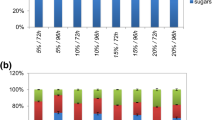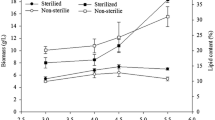Abstract
In this work, an integrated and optimized production process for 99 % pure 1,3-propanediol (PDO) from raw glycerol is presented. Glycerol fermentation is carried out applying a newly isolated strain Clostridium pasteurianum K1 under non-sterile conditions without any complex ingredients in the fermentation media. In this environment over 55 g/L PDO, yields of 0.52 g/g and space time yields over 2.3 g/(Lh) were achieved in up to 1 m3 pilot scale. The downstream process for PDO purification consists of an ultrafiltration for biomass and protein separation, an evaporation step for concentration of PDO and a two-step rectification for final purification. For a proof of concept, process optimization and especially investigation of interactions of individual steps, the downstream process was performed in miniplant scale. A minimum salt input into the downstream process was shown to be important to overcome precipitation in evaporation as well as rectification. Thus, raw glycerol is desalinated before fermentation and the fermentation medium was minimized and complex nutrients, such as yeast extract, were avoided totally to prevent furthermore dark color formation. Furthermore, by titration of fermentation with ammonia instead of sodium hydroxide, the later separation of the major by-products, organic acids, in the evaporation step was significantly enhanced.








Similar content being viewed by others
References
Ulber R, Soyez K (2004) 5000 Jahre Biotechnologie: vom Wein zum Penicillin. Chem unserer Zeit 38(3):172–180
Weizmann C (1919) Production of acetone and alcohol by bacteriological processes. US patent 1315585
Chiao J, Sun Z (2007) History of the acetone–butanol–ethanol fermentation industry in China: development of continuous production technology. J Mol Microbiol Biotechnol 13(1–3):12–14
Soetaert W, Vandamme EJ (2010) Industrial Biotechnology. WILEY-VCH, Weinheim
Hermann T (2003) Industrial production of amino acids by coryneform bacteria. J Biotech 104(1–3):155–172
Lunt J (1998) Large-scale production, properties and commercial applications of polylactic acid polymers. Polym Degrad Stabil 59(1–3):145–152
Sin LT, Rahmat AR, Rahman WAWA (2012) Polylactic acid: PLA biopolymer technology and applications. Elsevier, Oxford
Scholten E, Renz T, Thomas J (2009) Continuous cultivation approach for fermentative succinic acid production from crude glycerol by Basfia succiniciproducens DD1. Biotechnol Lett 31(12):1947–1951
BASF SE (2012) Press release. http://www.basf.com/group/pressrelease/P-12-444
BASF SE (2012) Press release. http://www.basf.com/group/pressrelease/P-12-363
Kurian JV (2005) A new polymer platform for the future—Sorona from corn derived 1,3-propanediol. J Polym Environ 13(2):159–167
Biebl H, Menzel K, Zeng A-P, Deckwer W-D (1999) Microbial production of 1,3-propanediol. Appl Microbiol Biotechnol 52:289–297
Saxena RK, Anand P, Saran S, Isar J (2009) Microbial production of 1,3-propanediol: recent developments and emerging opportunities. Biotechnol Adv 27(6):895–913
Forsberg CW (1987) Production of 1,3-propanediol from glycerol by Clostridium acetobutylicum and other Clostridium species. Appl Environ Microbiol 53(4):639–643
Xiu Z-L, Zeng A-P (2008) Present state and perspective of downstream processing of biologically produced 1,3-propanediol and 2,3-butanediol. Appl Microbiol Biotechnol 78(6):917–926
Zeng A-P, Biebl H (2002) Bulk chemicals from biotechnology: the case of 1,3-propanediol production and the new trends. Adv Biochem Eng Biotechnol 74:239–259
Biebl H (2001) Fermentation of glycerol by Clostridium pasteurianum—batch and continuous culture studies. J Ind Microbiol Biot 27:18–26
Deckwer W-D (1995) Microbial conversion of glycerol to 1,3-propanediol. FEMS Microbiol Rev 16(2–3):143–149
Willke T, Vorlop K (2008) Biotransformation of glycerol into 1,3-propanediol. Euro J Lipid Sci Tech 110(9):831–840
Reimann A, Biebl H, Deckwer W-D (1998) Production of 1,3-propanediol by Clostridium butyricum in continuous culture with cell recycling. Appl Microbiol Biotechnol 49:359–363
Malinowski JJ (1999) Evaluation of liquid extraction potentials for downstream separation of 1,3-propanediol. Biotechnol Tech 13:127–130
Malinowski JJ (2000) Reactive extraction for downstream separation of 1,3-propanediol. Biotechnol Prog 16(1):76–79
Günzel B (1991) Mikrobielle Herstellung von 1,3-Propandiol durch Clostridium butyricum und adsorptive Aufarbeitung von Diolen. Dissertation Technische Universität Braunschweig, Braunschweig
Li Z, Hu T, Xiu Z (2011) Extraction of 1,3-propanediol from glycerol-based fermentation broths with methanol/phosphate aqueous two-phase system. Process Biochem 46(2):586–591
Aydoğan Ö, Bayraktar E, Mehmetoğlu Ü, Kaeding T, Zeng A-P (2010) Selection and optimization of an aqueous two-phase system for the recovery of 1,3-propandiol from fermentation broth. Eng Life Sci 10(2):121–129
Grothe E (2000) Konzeption und Wirtschaftlichkeit der industriellen Glycerinvergärung zu 1,3-Propandiol. Dissertation Technische Universität Braunschweig, Braunschweig
Propanergy Projektbericht (2011) Marketing concept. http://www.propanergy.eu/cms/Content/download/Deliverable6_MarketingconceptforPDO.pdf
Majer S, Mueller-Langer F, Zeller V, Kaltschmitt M (2009) Implications of biodiesel production and utilisation on global climate—a literature review. Euro J Lipid Sci Tech 111(8):747–762
Wilkens E, Ringel A, Hortig D, Willke T, Vorlop K-D (2012) High-level production of 1,3-propanediol from crude glycerol by Clostridium butyricum AKR102a. Appl Microbiol Biotechnol 93(3):1057–1063
González-Pajuelo M, Andrade JC, Vasconcelos I (2004) Production of 1,3-propanediol by Clostridium butyricum VPI 3266 using a synthetic medium and raw glycerol. J Ind Microbiol Biotechnol 31(9):442–446
Chatzifragkou A, Papanikolaou S, Dietz D, Doulgeraki A, Nychas G-J, Zeng A-P (2011) Production of 1,3-propanediol by Clostridium butyricum growing on biodiesel-derived crude glycerol through a non-sterilized fermentation process. Appl Microbiol Biotechnol 91(1):101–112
Mu Y, Teng H, Zhang D-J, Wang W, Xiu Z-L (2006) Microbial production of 1,3-propanediol by Klebsiella pneumoniae using crude glycerol from biodiesel preparations. Biotechnol Lett 28(21):1755–1759
Dietz D (2013) 1,3-Propanediol production from raw glycerol by mixed cultures: from laboratory to pilot plant scales. Dissertation TU Hamburg-Harburg, Hamburg
Metsoviti M, Paraskevaidi K, Koutinas A, Zeng A-P, Papanikolaou S (2012) Production of 1,3-propanediol, 2,3-butanediol and ethanol by a newly isolated Klebsiella oxytoca strain growing on biodiesel-derived glycerol based media. Process Biochem 47(12):1872–1882
Metsoviti M, An-Ping Zeng A-P, Koutinas AA, Papanikolaou S (2013) Enhanced 1,3-propanediol production by a newly isolated Citrobacter freundii strain cultivated on biodiesel-derived waste glycerol through sterile and non-sterile bioprocesses. J Biotech 163(4):408–418
Dietz D, Zeng A-P (2013) Efficient production of 1,3-propanediol from fermentation of crude glycerol with mixed cultures in a simple medium. Bioprocess Biosyst Eng. doi:10.1007/s00449-013-0989-0
Greß D, Hartmann H, Kaibel G, Seid B (1979) Einsatz von mathematischer Simulation und Miniplant-Technik in der Verfahrensentwicklung. Chem Ing Tech 51(6):601–611
Buschulte TK, Heimann F (1995) Verfahrensentwicklung durch Kombination von Prozeßsimulation und Miniplant-Technik. Chem Ing Tech 67(6):718–723
Deibele L, Dohrn R (2006) Miniplant-Technik. WILEY-VCH, Weinheim
Aspen Tech (2006) Aspen plus documentation
Chatzifragkou A, Dietz D, Komaitis M, Zeng A-P, Papanikolaou S (2010) Effect of biodiesel-derived waste glycerol impurities on biomass and 1,3-propanediol production of Clostridium butyricum VPI 1718. Biotechnol Bioeng 107(1):76–84
Taconi KA, Venkataramanan KP, Johnson DT (2009) Growth and solvent production by Clostridium pasteurianum ATCC 6013 utilizing biodiesel-derived crude glycerol as the sole carbon source. Environ Prog Sustainable Energy 28(1):100–110
Sanz MT, Blanco B, Beltrán S, Cabezas JL, Coca J (2001) Vapor liquid equilibria of binary and ternary systems with water, 1,3-propanediol and glycerol. J Chem Eng Data 46(3):635–639
Melin T, Rautenbach R (2007) Membranverfahren. Grundlagen der Modul- und Anlagenauslegung. Springer, Heidelberg
Acknowledgments
The work presented here was kindly supported within the research project “PROPANERGY” in the Sevens Framework Program of the European Union (grant agreement no. 212671). We acknowledge also the support of the project partner BKW for scale-up study in their bio-pilot plant.
Author information
Authors and Affiliations
Corresponding author
Rights and permissions
About this article
Cite this article
Kaeding, T., DaLuz, J., Kube, J. et al. Integrated study of fermentation and downstream processing in a miniplant significantly improved the microbial 1,3-propanediol production from raw glycerol. Bioprocess Biosyst Eng 38, 575–586 (2015). https://doi.org/10.1007/s00449-014-1297-z
Received:
Accepted:
Published:
Issue Date:
DOI: https://doi.org/10.1007/s00449-014-1297-z




